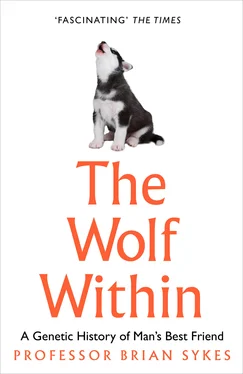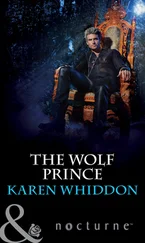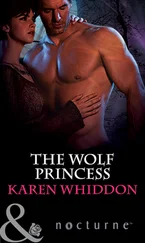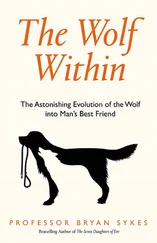The other unusual feature of mitochondria is that they are inherited only through the female line. The reason is that animal eggs are crammed full of mitochondria, while sperm don’t have any to speak of. To be entirely accurate, those few they do have don’t survive in the fertilised egg. This was the feature that appealed to Wilson and his team. Everyone inherits their mitochondrial DNA from their mother, who got it from her mother, who inherited it from her mother and so on back through time. Males and females have mitochondrial DNA – after all they both need to breathe oxygen – but only females pass theirs on to their offspring.
In complete contrast to mitochondria, the DNA in the cell nucleus is inherited more or less equally from both parents. This nuclear DNA controls most of the body’s functions, with the important exception of aerobic metabolism, which remains the responsibility of the mitochondria and its DNA. Unfortunately, ancestral connections traced backwards by nuclear DNA soon become extremely complicated. We all have two parents, four grandparents, eight great-grandparents, sixteen great-great-grandparents and so on. The number of ancestors doubles with each past generation, so by the time we go back only twenty generations, that’s about four hundred years for humans, we have over a million ancestors. It’s very unlikely that we have inherited DNA from all of those thanks to the random mixing of nuclear DNA with each generation, something I shall explain later in the book. Even so, we will have inherited DNA from a great many of them, but from whom we will never know. In comparison with this genetic muddle, there was only ever one woman in each generation who is our mitochondrial ancestor and whose DNA we have inherited. It is that simplicity which drew Allan Wilson to investigate mitochondrial DNA (or mDNA for short) rather than nuclear DNA in his representative sample of the world’s population.
The striking conclusion of this work was that if you went back far enough, everyone on the planet has inherited his or her mDNA from just one woman. In ways that we will come on to, Wilson estimated that she lived in Africa about 200,000 years ago. Unsurprisingly, she was immediately dubbed ‘Mitochondrial Eve’. The results also showed a clear connection between Africans and everyone else, suggesting that modern humans spent a long time in Africa before some of them left to populate the rest of the world. It’s as well to remind ourselves here that we are only considering strict female–female matrilineal inheritance, with no consideration, for now, given to the DNA from men.
It was a delightfully simple conclusion, although some people still find it confusing. Eve was certainly not the only woman alive at the time, just the only one to have direct matrilineal descendants living today. As now, couples can have only sons or no children at all, but it is only daughters who can pass mitochondrial DNA to the next generation. It follows that in the 10,000 or so generations since Eve, the only mDNA to survive to the present day has been passed along unbroken matrilineal lines, while that from Eve’s many contemporaries has been eliminated at some point along the way.
Though there have been some modifications in the ensuing thirty years, this overall concept of Mitochondrial Eve has stood the test of time. Wilson’s 1987 paper became a model for all future molecular genealogies, which have completely revolutionised our view of human origins. I analyse mitochondrial DNA samples from all over the world, and marvel at every one of them. They have each travelled unseen for tens of thousands of years in the cells of a continuous line of ancestors from ancient times until today when, at last, they reveal their secrets in the laboratory.
It took ten years before the Los Angeles-based biologists Robert Wayne and Carles Vilà published an equivalent genetic analysis for the dog.2 Like Wilson, they used mitochondrial DNA, but with a more advanced technique that examined the DNA sequence itself rather than the limited summary that was all that had been available to Wilson a decade earlier. I will say more later on about DNA sequences, including what they are and how to read them, but for now we will concentrate on the dogs.
Wayne and his team collected an impressive set of samples. In addition to 140 domestic dogs from 67 different breeds, Wayne also included wolves, coyotes and jackals in his analyses. The wolf collection came to a total of 162 animals from 27 locations worldwide. In addition, because they had been mooted as possible ancestors of modern dogs, Wayne included 5 coyotes and 12 jackals – 2 golden, 2 black-backed and 8 simien. When the mDNA sequences from all these animals were displayed in a molecular tree (referred to as Wayne’s tree) in the same way that Wilson had portrayed the human mitochondrial genealogy, the resemblance between the two was clear to see.
Wilson’s human tree (see here) divided the world population into two main branches, one African and a second containing both some African and all the people from outside Africa before coalescing on a single matrilineal ancestor – ‘Mitochondrial Eve’. The Wayne dog DNA tree consisted of four main branches, each with a different, but still closely related, ancestor. Most dog breeds were placed in the major branch, which Wayne called branch I, and included many of the common breeds as well as some so-called ‘ancient breeds’ like the dingo, New Guinea Singing Dog, African Basenji and Greyhound. Branch II contained two Scandinavian breeds, the Elkhound and the Jämthund, while branch III included a variety of breeds such as the German Shepherd, Siberian Husky and Mexican Hairless. Finally, branch IV included Wirehaired Dachshund, a Flat-coated Retriever and an Otter Hound. This last branch also contained a few wolves, one of which, from Romania, was the only wolf in the whole study whose sequence exactly matched that of a number of dogs including a Toy Poodle, a Bulldog and, surprisingly, another Mexican Hairless.
The simplified diagram (see here) only shows the major mitochondrial groups. Within each circle are a number of breeds. They are not shown here but can be inspected in the original,3 where there are many examples of exactly the same mDNA sequence being found in several different breeds. For example, a Norwegian Buhund, a Border Collie and a Chow Chow had precisely the same mitochondrial DNA sequence. Equally, the same breeds could have different mDNA sequences and appear on different branches of the tree. For instance, the eight German Shepherds had five different sequences between them. We will consider what this means a little later.
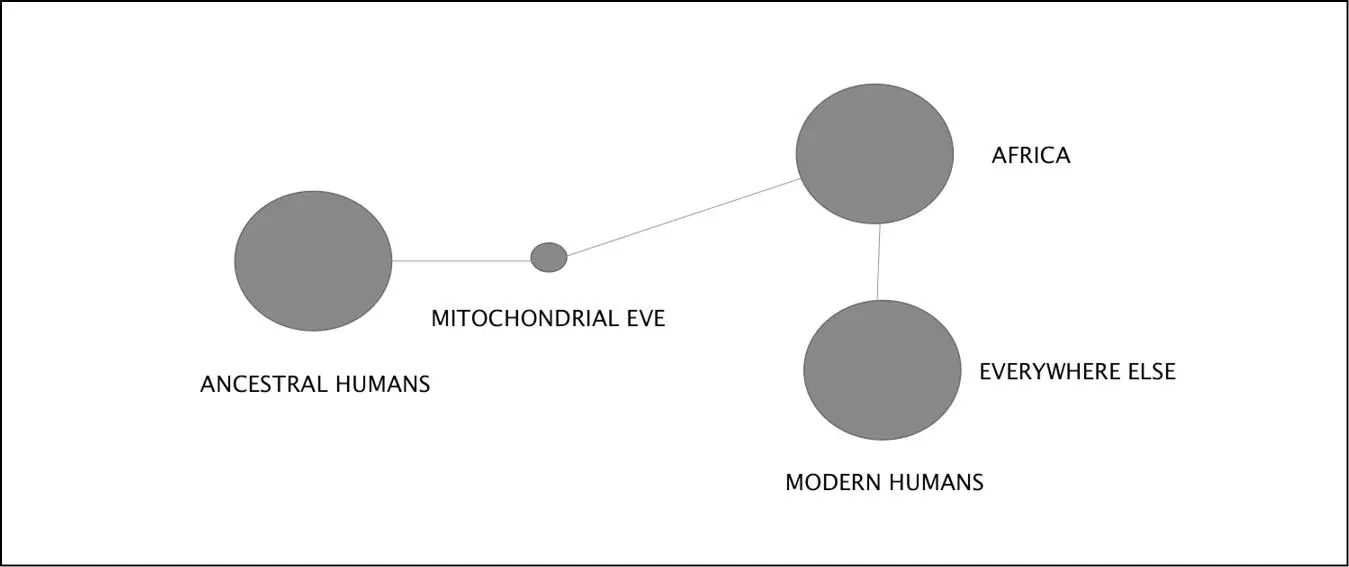
Wilson’s Human Tree (simplified). (Image courtesy of Professor Bryan Sykes)
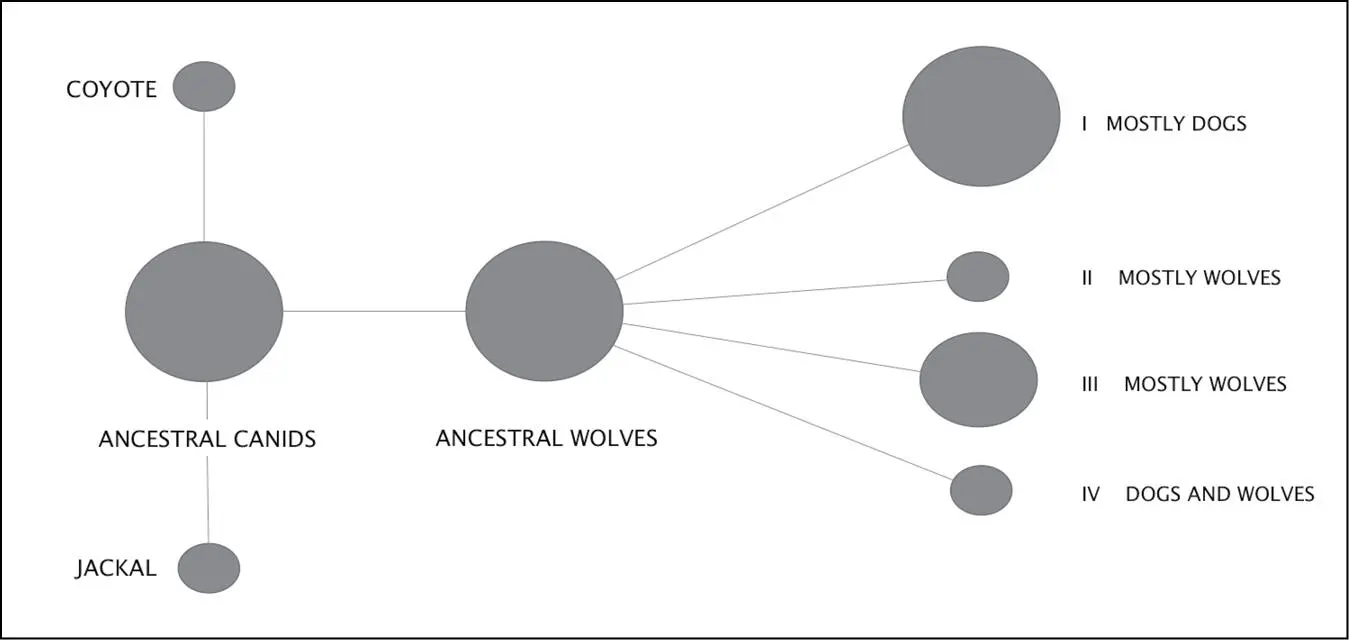
Wayne’s Dog Tree (simplified). (Image courtesy of Professor Bryan Sykes)
Had Darwin been alive to read it, he would have been itching to know where wolves, coyotes and jackals fitted into the tree, if at all. The answer was very clear. The coyote and jackal fell out of the main wolf/dog tree, as it were, immediately. Their DNA sequences were clearly quite different to all the dogs, and none made it into any of the four major branches. When it came to placing the wolf DNA sequences, the answer was equally striking, not because they were outside the dog tree but because they were deeply embedded within it. There was no doubt, from the mitochondrial DNA analysis, that all dogs were descended from wolves and from no other species. It was the first triumph of molecular genetics as applied to dogs – and by no means the last.
Читать дальше
